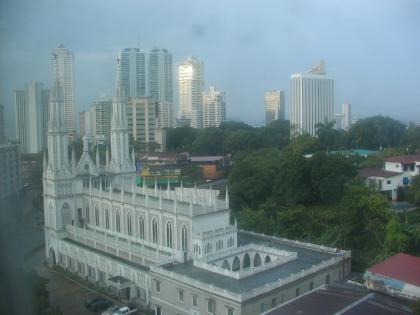PEACHFRONT SPEAKS
The Online Mineral Museum IS BACK!!!.
The Amazing Bolivian Parrot and Rare Macaw EscapadeEagle Overload: More Eagles, More Cats, the South Africa Edition
MY KENYA DIARY: IN QUEST OF EAGLES
MADAGASCAR DIARY: SERPENT-EAGLES, GOSHAWKS, AND MORE
A Very Partial Index to the Entries
A for the time being not even remotely complete guide to all 4,300+ plus entries
BIRDS***BIRDING***WILDLIFE GARDENING
SF/BOOKWORM***NUCLEAR/SPACE
A Google-Plus Verified Author
|
2003-06-18 - 10:04 p.m. 
� 2003 by Roger Williams, all rights reservedTime Zone: The time is the same as Eastern Standard Time, or Central Daylight Time, hence there is no jet lag for visitors from Louisiana or other central time zone locations in our summer. Languages: Spanish is the official language of Panama, but many people speak at least a little English. People are extremely friendly and are willing to work with you, even if you don't speak Spanish. Health: You don't need to take any special medicines to visit Panama City or the Canal zone area. You will probably want to bring insect repellent, but they don't even come close to getting the numbers of mosquitoes in June that we get in good birding areas at this time right here in Louisiana. You can drink the water right out of the tap, use ice cubes made from tap water, and eat salads and fresh fruits and vegetables without concern. The hotels are happy to sell bottled water to the paranoid, but don't bother unless you really prefer the taste of your favorite bottled water, because we drank tap water and ate salads and raw fruit like crazy, and we were just fine. There were no episodes of "traveler's trots." I am not a doctor, and I'm not responsible if you follow my advice and acquire some rare disease, but I honestly don't think you will. Money: You don't need to change your money, since Panama in its wisdom "prints" its currency, the balboa, by the simple act of stating that dollars circulating in Panama are balboas. Since it is physically the same as the U.S. dollar, it is of course of the same value. Nice and easy. Panama does mint its own coins, and you may wish to keep a few that you get in change as a souvenir of your trip. We brought a bunch of fives and ones to use as tips. Some restaurants and bars automatically add a 10 percent service charge for the tip. Others don't. So read your bill, so you will know whether you need to add more for the tip. Our travel agency suggested that we tip tour guides $4 per person for each half day tour. We just rounded this suggestion up to $5 per person because it seemed more convenient. We tipped $20 for the three hour tour of Pipeline Road as we were the only two people on the tour, and the guide went above and beyond the call of duty with his extreme helpfulness. Crime: Panama City and Gamboa appear to be extremely low crime areas. Even the cab drivers were honest, and street hustlers appeared to be nonexistent. Now, I realize that the United States is one of the most violent nations in the world -- in the 1980s, New Orleans used to boast that you were more likely to die of violence in New Orleans than in Beirut -- so it might not mean much to say you are more likely to encounter crime in any U.S. city than in Panama City. However, while I would never advise anyone to abandon their common sense, I have to say that we felt extremely safe wandering around the city pretty much at random. Birds: You will need a copy of A Guide to the Birds of Panama with Costa Rica, Nicaragua, and Honduras by Robert S. Ridgely and John A. Gwynne, Jr. As Panama has around 1,000 species of birds, this guide weighs a freakin' ton. If and when I return, I'm going to see if there is an edition with just the color plates, suitable for carrying around as I bird. If not, I plan to photocopy the color plates and have them bound for convenient carrying, so I can leave this huge book in the hotel room for checking at my leisure. Birding can be an overwhelming experience because of the number of species. I would recommend reviewing at least a few common species before your trip, so that you will spend less time flipping through the guide and more time observing birds. At a bare minimum, try memorizing the field marks of the following:
|
